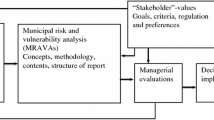Abstract
Conflict-sensitive social impact assessment (CSSIA) is to predict and analyze social risks triggered by public decision-making to realize source governance. Based on decision-making theories, this paper aims to explore the relationship between decision-making and risk source. Based on the field research of the policy-making process in contemporary China, this paper elaborates on the relationship between decision-making and risk accumulation in five aspects: the bounded rationality of decision makers, the deformation of decision structure, the fragmentation of decision-making process, the unduly frequency of policy change, and the excessively big size of policy gap. Promoting the transformation of the decision-making process is the key to dealing with the large-scale and high-risk social instability in the socioeconomic transition period. In the framework of developing countries, further research is needed to delve into the institutional arrangement of public decision-making to guarantee a well-ordered society. In the practices of CSSIA, the focus should not be simply put on the prediction and assessment of risks and emergency response, but more importantly on the analysis of contributing factors of risk evolution. This paper reveals that social instability occurs when the balance of social interests is broken and its root lies in the institutional arrangement of public decision-making. Therefore, promoting the transformation of decision-making system is the gist of CSSIA in the Chinese context and it can help make the source governance come true.
Similar content being viewed by others
Notes
From the News of the Communist Party of China, http://cpc.people.com.cn/GB/64162/71380/71387/71589/5526691.html.
From government website news, http://www.yandu.gov.cn/Article/dwgk/zdgz/201110/51220/html.
From government website news, http://zjfzb.gov.cn/il.htm?a=si&key=main/xwzx/dtxw/zhxw&id=5c3f755b4419c0ec014500fdd7351895.
From government news, http://www.hangzhou.gov.cn/main/zwdt/ztzj/kfsjc/wenjian/T301396.shtml.
From government news, http://www.hangzhou.gov.cn/main/zwdt/ztzj/kfsjc/wenjian/T301396.shtml.
The eight categories are: (1) government report, report of the socioeconomic plan of Hangzhou city, and financial report; (2) urban planning and major special projects; (3) important drafts of local government regulations; (4) important reform plan and public policy that are closely related to the interests of the general public; (5) major adjustments of daily operations and public service for the public; (6) major public activities that are closely related to the life and work of the public, and the response plan for public emergencies; (7) major issues on the self-construction of government; (8) other major issues put forward by the mayor.
From government website news, http://www.shmec.gov.cn/attach/xxgk/6538.doc.
These figures are from the authors’ field research in the 16 administrative districts of Shanghai in 2013.
From government website news, http://www.gov.cn/jrzg/2011-07/15/content_1906723.htm.
This definition comes from the Risk Management Terminology of the National Standards of the People’s Republic of China (GB/T 23694-2009/ISO/IEC Guide 73:2002).
References
Becker, H., and F. Vanclay. 2003. The international handbook of SIA. Cheltenham: E Elgar.
Bennett, C.J., and M. Howlett. 1992. The lessons of learning: reconciling theories of policy learning and policy change. Policy Sciences 25 (3): 275–294.
Bullock, J.B., R.A. Greer, and L.J. O’Toole. 2018. Managing risks in public organizations: a conceptual foundation and research agenda. Perspectives on Public Management and Governance 2 (1): 75–87.
Campbell, J.L. 2002. Ideas, politics, and public policy. Annual Review of Sociology 28 (1): 21–38.
Capano, G. 2013. Policy dynamics and change. New York: Routledge.
Chan, H.S. 2004. Cadre personnel management in China: the nomenklatura system, 1990–1998. The China Quarterly 179: 703–734.
Chen, Feng. 1997. Order and stability in social transition: neoconservative political thought in post-China. The China Quarterly 151: 593–613.
Deng, Xiaoping. 1994. Selected works of Deng Xiaoping. Beijing: People’s Publishing House.
Feng, Xingyuan. 2010. Competition among local governments. Shanghai: Yilin Press.
Fenger, M., and V. Bekkers. 2012. Creating connective capacities in public governance: challenges and contributions. Beyond fragmentation and interconnectivity. Public governance and the search for connective capacity. Washington: IOS Press.
Gigerenzer, G., and R. Selten. 2001. Rethinking rationality. Bounded rationality: the adaptive toolbox. Cambridge: MIT Press.
Jacquelien, Van Stekelenburg, and Bert Klandermans. 2017. Individuals in movements: a social psychology of contention. Cham: Springer.
John, P. 2003. Is there life after policy streams, advocacy coalitions, and punctuations: using evolutionary theory to explain policy change? Policy Studies Journal 31 (4): 481–498.
Jones, B.D., and H.F. Thomas. 2012. Bounded rationality and public policy decision-making. New York: Routlegde.
Kydland, F.E., and E.C. Prescott. 1977. Rules rather than discretion: the inconsistency of optional plans. Journal of Political Economy 87: 473–492.
Lieberthal, K., and M. Oksenberg. 1990. Policy making in China: leaders, structures, and processes. Princeton: Princeton University Press.
Lieberthal, Kenneth G. 1992. Bureaucracy, politics, and decision making in post-Mao China. California: University of California Press.
Manion, M. 1985. The cadre management system, post-Mao: the appointment, promotion, transfer and removal of party and state leaders. The China Quarterly 102: 203–233.
McLean, I., and A. McMillan. 2009. The concise Oxford dictionary of politics. Oxford: Oxford University Press.
Mertha, A. 2009. “Fragmented authoritarianism 2.0”: political pluralization in the Chinese policy process. The China Quarterly 200: 995–1012.
Ostrom, Elinor. 2009. Understanding institutional diversity. Princeton NJ: Princeton University Press.
Prenzel, Paula V., and Frank Vanclay. 2014. How social impact assessment can contribute to conflict management. Environmental Impact Assessment Review 45: 30–37.
Poncet, Sandra. 2005. A fragmented China: measure and determinants of Chinese domestic market disintegration. Review of International Economics 13 (3): 409–430.
Simon, Herbert A. 1957. Models of man; social and rational. New York: Wiley.
Xie, Yue. 2012. The Political logic of weiwen in contemporary China. Issues and Studies 48 (3): 1–41.
Zhu, Demi. 2012. Policy gap, risk source, and conflict-sensitive social impact assessment. Comparative Social and Economic Systems 2: 170–177.
Zhu, Demi. 2016. A Study of Conflict-Sensitive Social Impact Assessment on Public Decision-Making in China. Beijing: Science Press.
Zhu, Demi. 2014. Building an institutional path to combine rights protection and stability maintenance. Fudan Journal (Social Sciences Edition) 56 (1): 147–156.
Author information
Authors and Affiliations
Corresponding author
Rights and permissions
About this article
Cite this article
Zhu, D., Cao, S. Decision-Making and Risk Sources: Key to Source Governance for Social Stability. Chin. Polit. Sci. Rev. 5, 95–110 (2020). https://doi.org/10.1007/s41111-019-00126-0
Received:
Accepted:
Published:
Issue Date:
DOI: https://doi.org/10.1007/s41111-019-00126-0




